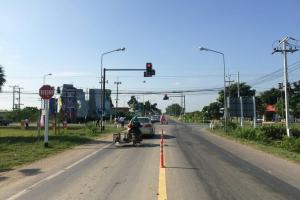Thailand Accident Research Center
ศูนย์วิจัยอุบัติเหตุแห่งประเทศไทย
Promoting Traffic Engineering Measures for Black Spot Improvement in Thailand
The goal of this project is to improve the road safety by implementing engineering measures, to evaluate performance of engineering measures by conducting before-after analysis, and to present the benefits of engineering measures to policy makers and provide data for other similar projects. The total of 10 black spot locations will be selected from different provinces in Thailand. Then, the process of studying sites, data collection, conceptual and detailed design, and implementation of appropriate improvement will be conducted.
In Thailand, Thailand Accident Research Center (TARC) at Asian Institute of Technology (AIT) has observed the common safety deficiencies at black spots which can be summarized as the following locations:
- Unsignalized intersection with poor sight distance
- Signalized intersection with red light running behavior due to inappropriate signal timing and traffic light installation
- Pedestrian Crossing with poor markings and signs
- Speeding in Built-up area
Unsignalized and Signalized Intersection
According to statistical crash data at intersection in Thailand (Figure 3), 9-13% of all crashes and 10-15% of all fatal crashes on national highways occurred at intersection. Based on the data from 2008-2011, crashes at intersection caused more than 1,300 deaths per year, and the trend is increasing continuously. For the crashes at unsignalized intersection, it has been found that poor sight distance is one of the major contributing factors to the crashes, while the red light running behavior has been reported as the major contributing factor of the crashes at signalized intersection. The red light running behavior is caused by not only the human error, but also the poor design of traffic signal timing and traffic light installation.
In this project, the roundabout will be implemented as the engineering measure for the safety improvement at intersection. The roundabout has been proven as a safety countermeasure due to the reduction in vehicle speeds, the reduction in conflict points, and the improved crash rate and injury rate records. In addition, the roundabout can lower overall delay than other controlled intersections in typical conditions.
Pedestrian Crossing
In 2009, the Ministry of Public Health has reported that 77% of the number of road crash injuries is motorcyclists, followed by non-motorized user such as pedestrian and cyclists which shows 11% of the number of road crash injuries. The statistical data has clearly shown that the vulnerable road users, mainly pedestrians and two-wheel riders, are the most seriously affected groups among the traffic crash victims. Considering the age group of pedestrian and cyclists, it was observed that pedestrian with age group of 1-9 years old and cyclists with age group of 1-14 years old have higher risk to the crashes. Additionally, the crash data also indicates the time periods when young pedestrians always have accident. Accident data also shows that most young pedestrian crashes occur during 16.00-18.00 which is the time period after school finishes. One of the problems could be the lack of road safety around school areas including the provision of safe crossing in the school zones.
Approaches to reduce young pedestrian-motor vehicle collisions in school areas include engineering changes and methods to alert drivers and pedestrian to one another’s presence. In this project, the safe pedestrian crossing will be implemented in the school zones. The appropriate crossing facilities will be selected including the key design issues such as the zebra crossing, pedestrian islands, curb crossing, raised platform, and etc.
Speeding in Built-Up Area
Speed management is a significant challenge to reduce traffic crashes in Thailand especially in small and rural communities where the main roadway through towns or villages serves most of the transportation needs. Outside the towns or villages, the roadway provides high-speed travel over long distances; within the built-up area, however, the same roadway accommodates local access, pedestrian of all ages, on-street parking, bicycles, and other features of the community.
Currently, speed management in Thailand has focused only on the law enforcement by police. However, the law enforcement alone is often leads to temporary compliance at significant cost. A more permanent way to reinforce speed reduction is to change the look and feel of the road by installing traffic calming treatments that communicate to drivers that the function of roadway is changing. In Thailand, traffic calming is not used extensively, and not many techniques have been applied. However, traffic calming is very common in Europe and USA where several measures such as colored pavement, physical lane narrowing, signing, and landscaping are often combined. In this project, a gateway treatment will be implemented to lower speed on the approach and entrance to communities, and followed by a series of other measures to encourage drivers to maintain appropriate speeds.


